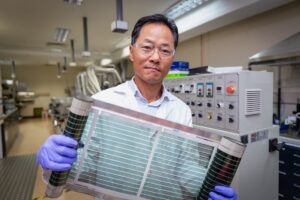A US researcher is trying to harness the power of plants – specifically their molecules that give off light – to make electricity with a hope of making solar panels smaller and more efficient.
The concept, which is being designed by University of Maryland researcher Lahari Saha, adapts plants’ energy making abilities to electricity and then uses their fluorescence, or light giving properties, to transfer that power to a storage system.
“Any sort of molecule that fluoresces, gives off light. If we excite the fluorophore, it can transfer its energy to metal nanoparticles, and if the particles are close enough to each other, they will knock off electrons and generate current,” Saha said in a statement.
Solar photovoltaic panels made of silicon can only convert about 20 per cent of the sun’s energy to electricity. It means vastly more, and larger, panels are needed to transition the world’s power from fossil fuels to renewable energy — many of which are controversially co-located on or in productive farmland.
If Saha’s research works, it could shrink panels while retaining, or even improving efficiency, and reduce the land required for solar farms.
It could also be another revolution for rooftop solar panels. While Australians have adopted rooftop solar with enthusiasm unmatched around the world, houses with roofs that face the wrong direction or are in locations without much direct sunlight miss out on the benefits. Small, more powerful panels could turn every house in the country into a power plant.
Saha is hopeful that her solar panels will be primarily plant-based molecules and other materials that are relatively prevalent like copper, making them easier to recycle when the time comes. Plus, by selecting materials with greater longevity, she hopes the solar panel will last longer before it is time to dispose of them.
Plant power
Certain biological molecules, such as chlorophyll, display fluorescence when exposed to light. It’s this property that allows them to convert light energy into chemical energy during photosynthesis.
The molecules might be able to capture more of the sun’s energy and convert it into electricity than the traditional photovoltaic design.
Saha’s research is on a technique called fluorophore-induced plasmonic current (FIPC). This is a way of making electricity by flowing a liquid that contains the fluorescent molecule –a fluorophore — over a film of plasma.
Electricity is produced by varying the amount of fluorophore in the liquid, which interacts with the film to create a current.
The trick is to find the specific concentrations to create the maximum charge — a number Saha is closing in on and will present at the 67th Annual Biophysical Society Meeting in San Diego, California.
“Our preliminary data on thin film fabrication demonstrates an increase in current response within the working range as well as lower signal to noise, leading to a stable baseline current,” she said in an abstract for the conference.
There’s always a ‘but’
Scientists have long been trying to figure out how to put nature’s bounty to work making electricity, but it’s a very early area of research and the technical challenges are high.
Molecules such as chlorophyll a and b, those found in plants and studied by Saha, are very unstable when faced with light, heat, chemicals, moisture. In short, they degrade quickly when faced by everything they encounter outside a lab.
The efficiency of chlorophyll is also very low. If inorganic solar panels can convert some 20 per cent of sunlight to electricity, chlorophyll efficiency is about 6 per cent, according to MIT engineers. The difference is that plants absorb almost all of the light in the spectrum. A solar panel reflects about a third of the light away and absorbs only about two-thirds.
The plant-power field is a growing area of interest for environmentally-minded scientists, however.
There’s biophotovoltaics which are devices that use enzymes or photosynthetic proteins to turn light into electricity. Dye-sensitised solar cells use a dye molecule usually based on a natural pigment like chlorophyll to do the same. Organic solar cells use organic molecules, while biohybrid solar cells use both biological and non-biological components.
Research into fluorescence includes a 2013 projects by scientists at Yale, who improved the way a solar cell absorbed light and converted it to electricity by adding a fluorescent organic dye.










